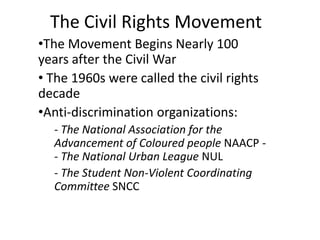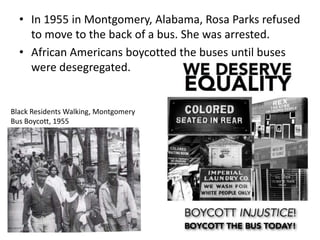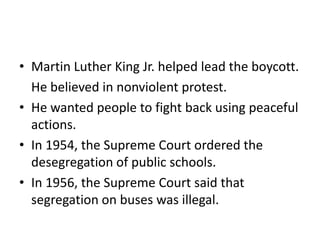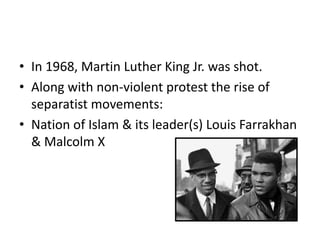Civil rights movement
- 1. The Civil Rights Movement •The Movement Begins Nearly 100 years after the Civil War • The 1960s were called the civil rights decade •Anti-discrimination organizations: - The National Association for the Advancement of Coloured people NAACP - The National Urban League NUL - The Student Non-Violent Coordinating Committee SNCC
- 2. • The civil rights of African Americans were limited by state laws and discrimination. • In the early 1950s, segregation was legal. • An Alabama law said that African Americans had to sit at the back of the bus.
- 3. • In 1955 in Montgomery, Alabama, Rosa Parks refused to move to the back of a bus. She was arrested. • African Americans boycotted the buses until buses were desegregated. Black Residents Walking, Montgomery Bus Boycott, 1955
- 4. • Martin Luther King Jr. helped lead the boycott. He believed in nonviolent protest. • He wanted people to fight back using peaceful actions. • In 1954, the Supreme Court ordered the desegregation of public schools. • In 1956, the Supreme Court said that segregation on buses was illegal.
- 5. Civil Rights Victories • In 1960, African Americans held sit-ins in 54 cities. • They sat at lunch counters that only served food to white people. They would not leave until they were served. • In 1963, Congress was discussing a bill to end segregation.
- 6. • Martin Luther King Jr. and other leaders organized a protest march in Washington, D.C., to show support for the bill. • The Civil Rights Act of 1964 banned segregation in schools, at work, and in public places. • Affirmative action to give minorities increased opportunities for higher education and in the workplace • Busing to promote desegregation
- 7. • In 1968, Martin Luther King Jr. was shot. • Along with non-violent protest the rise of separatist movements: • Nation of Islam & its leader(s) Louis Farrakhan & Malcolm X
- 8. HOWEVER • African-Americans tend to have a high dropout rate: only 15% complete 2 or more years of college Vs 26% of whites • Glass ceiling: For those who reach higher positions, discrimination prevents them from the top positions and professional advancement • They are hit twice as hard by unemployment as the rest of the population • They live in inner cities where violence and crime are widespread • The leading cause of death for a young black male is murder (very often by other black teenagers from different gangs. • Half inmates of American prisons are black • Housing segregation leads to poor social integration








